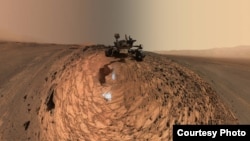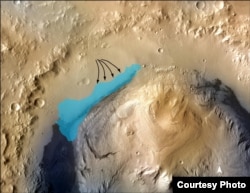Recent studies of the history of water on Mars indicate that the planet has a much wetter past than previously thought.
The latest study, reported October 8 in the journal Science, describes a system of deltas and lakes that dominated the Martian landscape more than 3 billion years ago. This builds on news NASA released a week earlier that water flows on the red planet today.
John Grotzinger, professor of geology at the California Institute of Technology, is the lead author of the study, which is based on image data sent from Curiosity, the rover working on Mars since 2012. He wrote, “Curiosity provides the capability to test hypothesizes about Mars' past climate.”
The robot geologist explored Gale Crater, a 140-kilometer-wide impact crater, with a 5-kilometer-high mountain at its center.
Marjorie Chan, a geology professor at the University of Utah, reviewed the Science article in a piece accompanying the research. She wrote, “Deciphering this geology is built on detective work, searching for clues and signs to tell us about past conditions, environments and places where water could have harbored life-forms.”
Gale Crater is of particular interest because of the piles of layered rock formed by deposits of sediment, laid down over eons. “Generally when we have these nice layers, those are often laid down by water,” Chan said. “So we knew that there was a potential that this could show the history of water on Mars' past surface.”
Ancient network
According to the study, the rocks in the crater date back between 3.6 and 3.2 billion years, with the youngest on the higher strata. By comparison, Earth is 4.5 billion years old. Chan said what scientists see in Curiosity's images is evidence of a lake bed and a more extensive underground water network.
“The rover showed that there are different types of features that were the feeders into a lake — such as rivers that carry courser sediment and deltas that are actually depositing some of the sediment — and then the standing body of water, this lake, where some of the sediment might have settled out under more quiet conditions.”
Chan said the study shows a combination of moving and standing water that aren't on the planet's surface today, and establishes a framework for scientists trying to understand ancient Mars.
“Putting together this history really gives us a much more complete picture of what’s been happening over time," she said. "In some way we’ve been getting these little glimpses here and there, but now we are really going to be able to start putting together a much bigger story."
Return to Mars
NASA plans a return trip to Mars in 2020. The new robot on board would identify and select rock and soil samples, storing them to return to Earth in a future mission. Chan wrote, “The more the geology looks like Earth, the more likely it seems that some life-form(s) could have developed in the Martian waters."















